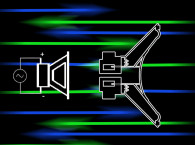- on Theory Articles
- Article
An Experiment With Higher Frequency Delay Dispersion
Being most familiar with woofer CO effects, I wanted to hear the effects at higher frequencies. So I replaced all ten 10nF caps in the breadboard with 2n2 values. This raised the all-pass phase shift fo to 1060kHz, while decreasing To to 300μS per stage, or 3mS for all ten stages.
Listening to individual step pulses (1Hz square wave) on Sennheiser HD650 phones, I could (barely) hear the effect of even one all-pass stage: a very slight dulling of the sharp clicks. With all ten stages, I could easily hear the blurring into that “teeooup” sound. With square waves around 20-100Hz, the effects were similar, and the “raspy” character was progressively reduced with more stages.
Then I tried an asymmetrical sawtooth wave (containing all harmonics, even and odd, in a –6dB/octave decreasing series). From about 200-500Hz, the sound somewhat resembles a violin tone (but non-resonant and much more “buzzy”). I was surprised by how much the all-pass time dispersion muted the sound, but only at SPLs above about 70dB. The latter confirms that it’s the ear’s nonlinearity that generates its own added harmonics, and these (as well as whether they reinforce or cancel the source’s harmonics) are sensitive to phase shifts (between the source harmonics).
In fact, as Lipshitz and Vanderkooy (in an AES article whose identity I don’t remember) stated, simply inverting an asymmetrical waveform, at moderate or higher SPL and on phones or very coherent speakers, can make a distinct difference on its tone. You can easily hear this if you have two sine wave oscillators, an oscilloscope, and a pair of headphones: sum the two oscillators (e.g., with a pair of 10k resistors joined to the scope and headphone amp). Set one to about 200Hz, and the other as close as possible to twice the first one’s frequency. Set the octave-higher frequency level to about one-third the amplitude of the lower frequency. Watching the scope, carefully tune one frequency so the waveform becomes almost stationary. Try to tune so the waveform variation repeats about once every two seconds. Then listen at a fairly loud volume (but not loud enough to distort the phones or amp). You will hear a truly dramatic cycling tonal change, but it’s only the phase relation between this synthesized fundamental and second harmonic that’s changing! You can very easily rule out possible distortion effects by moving the phones several inches away from your ears—the tonal changes will vanish!
Being most familiar with woofer CO effects, I wanted to hear the effects at higher frequencies. So I replaced all ten 10nF caps in the breadboard with 2n2 values. This raised the all-pass phase shift fo to 1060kHz, while decreasing To to 300μS per stage, or 3mS for all ten stages.
Listening to individual step pulses (1Hz square wave) on Sennheiser HD650 phones, I could (barely) hear the effect of even one all-pass stage: a very slight dulling of the sharp clicks. With all ten stages, I could easily hear the blurring into that “teeooup” sound. With square waves around 20-100Hz, the effects were similar, and the “raspy” character was progressively reduced with more stages.
Then I tried an asymmetrical sawtooth wave (containing all harmonics, even and odd, in a –6dB/octave decreasing series). From about 200-500Hz, the sound somewhat resembles a violin tone (but non-resonant and much more “buzzy”). I was surprised by how much the all-pass time dispersion muted the sound, but only at SPLs above about 70dB. The latter confirms that it’s the ear’s nonlinearity that generates its own added harmonics, and these (as well as whether they reinforce or cancel the source’s harmonics) are sensitive to phase shifts (between the source harmonics).
In fact, as Lipshitz and Vanderkooy (in an AES article whose identity I don’t remember) stated, simply inverting an asymmetrical waveform, at moderate or higher SPL and on phones or very coherent speakers, can make a distinct difference on its tone. You can easily hear this if you have two sine wave oscillators, an oscilloscope, and a pair of headphones: sum the two oscillators (e.g., with a pair of 10k resistors joined to the scope and headphone amp). Set one to about 200Hz, and the other as close as possible to twice the first one’s frequency. Set the octave-higher frequency level to about one-third the amplitude of the lower frequency. Watching the scope, carefully tune one frequency so the waveform becomes almost stationary. Try to tune so the waveform variation repeats about once every two seconds. Then listen at a fairly loud volume (but not loud enough to distort the phones or amp). You will hear a truly dramatic cycling tonal change, but it’s only the phase relation between this synthesized fundamental and second harmonic that’s changing! You can very easily rule out possible distortion effects by moving the phones several inches away from your ears—the tonal changes will vanish!





